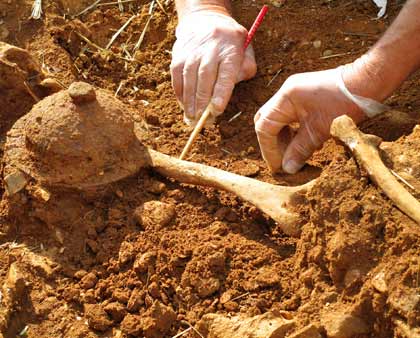
Two new skeletons of a shield-bearing man and an adolescent female have been found buried in an early Anglo-Saxon cemetery first discovered more than ten years ago near Northampton.
Archaeologists say the man and teenager were both buried with personal knives within Whitehall Farm, at Nether Heyford. Metal detectorists identified nine graves at the site in 2004.
"The same detectorists were re-examing the field and located two further graves which were excavated," says David Hayward, of the Community Landscape Archaeology Survey Project.
"The first grave contained a male, 1.98 metres in height, who had been buried with a shield laying on his chest and also a personal knife.
"The boss of the shield was still in the grave in remarkably good condition and has been recovered intact. This burial was on a north-south alignment, probably from the 6th century.
"The second grave revealed an adolescent female of fairly tall stature, buried with her domestic knife.
"This grave was on an east-to-west alignment and was probably the earlier of the two, from the 5th century.
"The previous burials were also on mixed alignments, the earliest being east-to-west. From other indications in this area, there was possibly a very early Christian heritage that was subsequently changed to the pagan religion of later influence.

Archaeologists originally excavated the graves to protect them from damage caused by farming activities. The developments are the latest discoveries made by the community archaeology project, which has been investigating a villa at the site and the walled Roman posting station of Bannaventa, which could have been a high-class overnight guest house for high-status travellers.
A triangle of landscape east of Watling Street, in west Northamptonshire - one of Roman Britain's main arterial roads, connecting London with the north-west via a busy and commercial highway - has been explored by the group in an area covering 148 square kilometres near the River Nene.
The evidence shows that the area was densely occupied by the late Iron Age, suggesting that the Roman conquest witnessed a slow absorption of the local population of small, enclosed farmsteads.
Many of the survey areas have sight lines to Iron Age hillforts at Borough Hill and Hunsbury Hill, and previous fieldwork suggests that the area may have been extensively occupied during the Bronze Age.
A wide consultation took place on the re-interment of the original remains, with their religion remaining uncertain. Having consulted historical papers, the group reburied the bodies with replica items during a respectful ceremony.
"You've got to do something," says Hayward. "You can't put everything into museums. I think it was proper to treat them respectfully. I hope someone would treat me respectfully in 1,000 or 1,500 years' time."
"When these people were buried, it was thought important enough that they actually had something of personal worth to them interred with them," says Stephen Young, the Archaeology Director of the project.
"We can't actually do what the Saxons would have done because we're not able to discuss it at first-hand with them, nor can we really make up something and think that's what they did.
"Although we can't replace the original, we're recognising the fact that that is something they wanted with them in the next world, whether that is a Christian one, a Pagan one or a mixture of both.
"In the past, when people have recovered grave goods and skeletons in cemeteries, they've often just laid on archive shelves for years. These people were buried by people who loved them and the idea was to leave them in perpetuity within the landscape that they were part of."
The project aims to piece together an overall picture of the locality between late Iron Age and early post-Roman times. CLASP is also assisting Oxford University's attempt to construct an Iron Age Hillforts Atlas.




Reader Comments
to our Newsletter